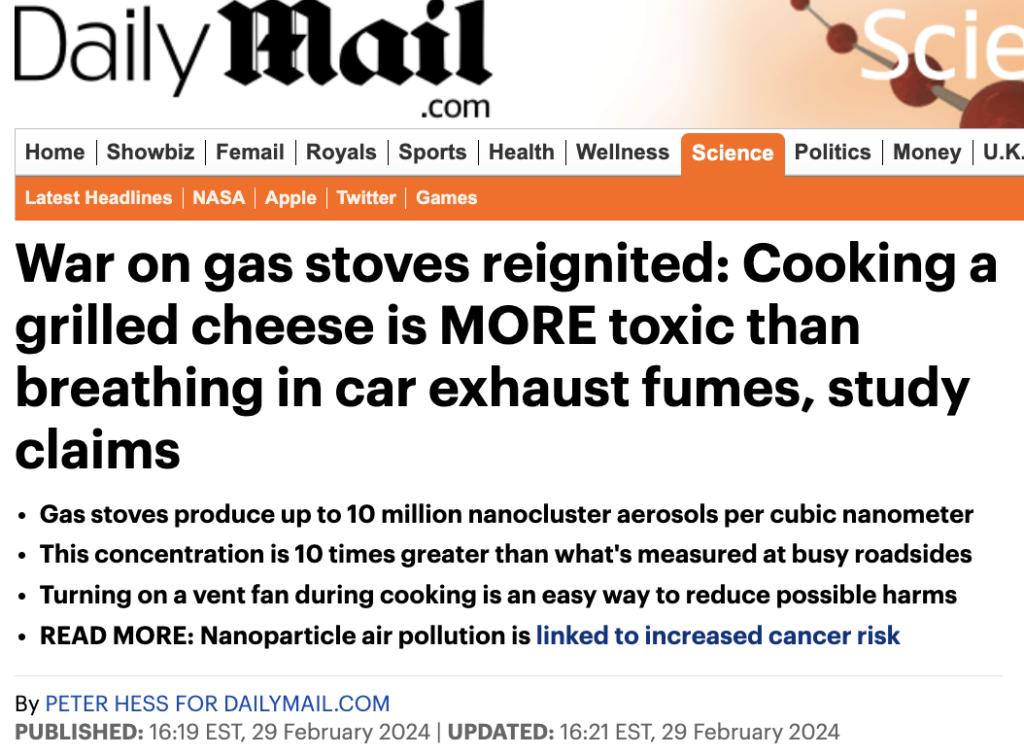By PETER HESS FOR DAILYMAIL.COM
The natural gas stove in your home could be emitting more harmful nanoparticles than a gasoline-powered car’s tailpipe, according to new research.
Clouds of these tiny particles, also known as soot, are between one and three nanometers each. They are just the right size to stick in your lungs and infiltrate the bloodstream, said the scientists from Purdue University and Indiana University who conducted the new study.
Researchers found cooking a simple grilled cheese sandwich may expose residents to as many as 10 million nanocluster aerosols per cubic nanometer, compared to the up to around 1 million released by cars near a busy street.
The news comes about one year after some officials at the US Consumer Product Safety Commission considered banning gas stoves – a move that never materialized but became a political lightning rod.
Being exposed to millions of pieces of particulate matter, even over relatively short periods of 24 hours, can be harmful, according to the California Air Resources Board.
Nanocluster aerosols can contribute to respiratory diseases like asthma and bronchitis, and increase a person’s chances of having to go to the hospital for heart or lung causes.
Exposure to these nanoparticles has even been linked to dementia and cognitive decline.
More than one-third of homes in the US, about 47 million, have propane or natural gas stoves.
‘Combustion remains a source of air pollution across the world, both indoors and outdoors,’ said lead study author Brandon Boor, associate professor of civil engineering at Purdue, in a statement.
‘We found that cooking on your gas stove produces large amounts of small nanoparticles that get into your respiratory system and deposit efficiently.’
The team used an air quality system to test nanoparticles inside a ‘tiny house’ lab, which was equipped with sensors for closely monitoring the impact of everyday activities on a home’s air quality.
In addition to measuring how many nanocluster aerosol particles a propane stove generates, the scientists also used computer models to estimate how many of the particles someone could breathe in.
Trillions of nanocluster aerosol particles were emitted within just 20 minutes of boiling water or making grilled cheese sandwiches or buttermilk pancakes on a gas stove.
And during that 20-minute period, they estimated that an adult could be breathing in between 10 billion and one trillion of those particles.
This is between 10 and 100 times the dose of soot that you would receive from standing by a busy street for the same amount of time, the study’s authors wrote.
The study only examined the nanoparticles from gas stoves and cars, not the other air pollutants like nitrogen oxide or carbon monoxide.
The nanocluster aerosol coming from the gas stove was also found to easily mix with larger particles entering the air from butter, oil or whatever else is cooking on the gas stove.
Even though the concentrations of particles rose rapidly during cooking, reaching their peak after about 20 minutes, they dissipated quickly.
The data indicates that the particles settle out of the air just about as quickly, falling back to baseline levels in 10 to 20 minutes.
This is probably due to the combined effects of ventilation and the fact that the particles settle onto surfaces.
The situation is similar with cars: As long as they are being emitted, they are in the air. But once the stove is turned off or the cars stop rolling by, the soot will soon settle.
Fortunately, there is a simple way to reduce the concentration of these harmful particles.
For people who have one of these stoves in their home, the scientists behind the study recommend turning on a vent fan whenever they cook on it.
‘Since most people don’t turn on their exhaust fan while cooking, having kitchen hoods that activate automatically would be a logical solution,’ Boor said.
‘Moving forward, we need to think about how to reduce our exposure to all types of indoor air pollutants,’ he continued. ‘Based on our new data, we’d advise that nanocluster aerosol be considered as a distinct air pollutant category.’
The study was published Tuesday in the journal PNAS Nexus.
…
The natural gas stove in your home could be emitting more harmful nanoparticles than a gasoline-powered car’s tailpipe, according to new research. Clouds of these tiny particles, also known as soot, are between one and three nanometers each. …
Researchers found cooking a simple grilled cheese sandwich may expose residents to as many as 10 million nanocluster aerosols per cubic nanometer, compared to the up to around 1 million released by cars near a busy street. The study was published Tuesday in the journal PNAS Nexus. …
The news comes about one year after some officials at the US Consumer Product Safety Commission considered banning gas stoves – a move that never materialized but became a political lightning rod. … The nanocluster aerosol coming from the gas stove was also found to easily mix with larger particles entering the air from butter, oil or whatever else is cooking on the gas stove. … Moving forward, we need to think about how to reduce our exposure to all types of indoor air pollutants,’ he continued. ‘Based on our new data, we’d advise that nanocluster aerosol be considered as a distinct air pollutant category.’





